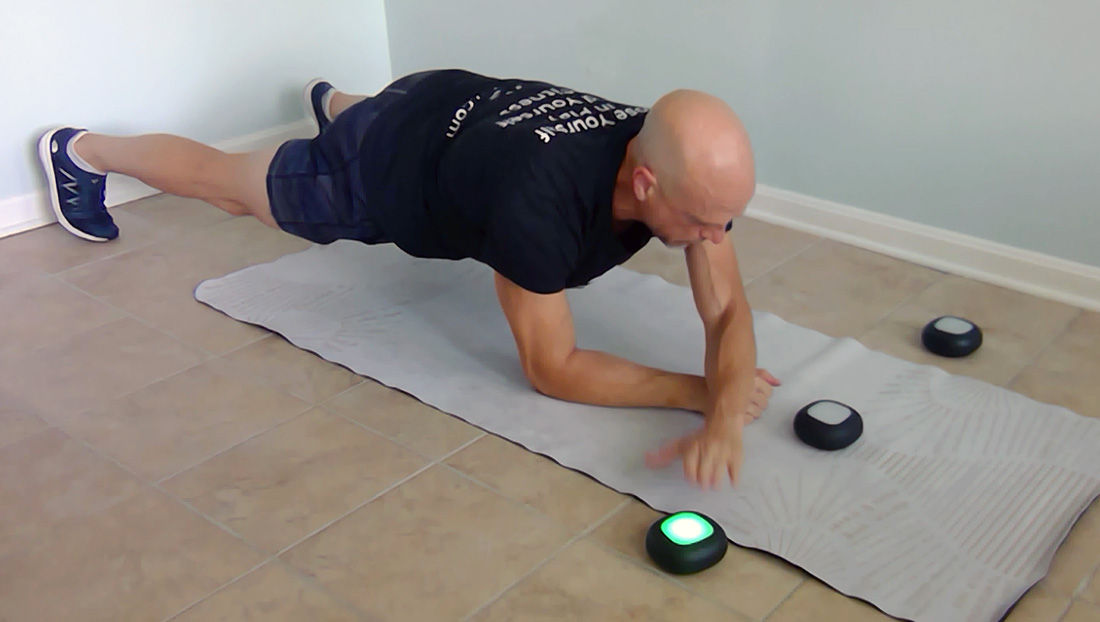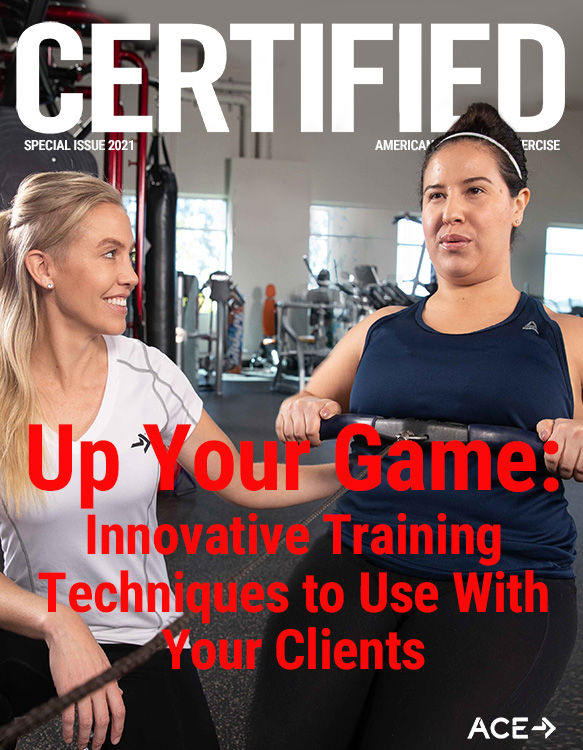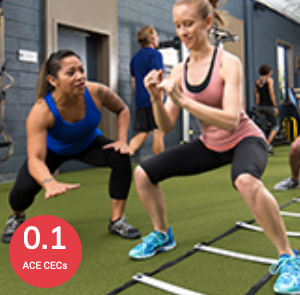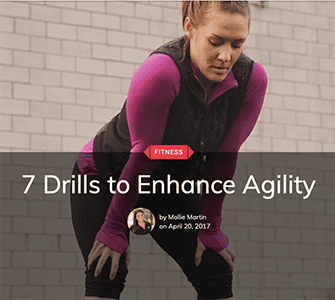
Is it better to move or to think and move?
As exercise professionals, we aim to get people moving. As forward-thinking exercise professionals, perhaps we should aim to get more people to think and move simultaneously.
When you combine a cognitive challenge with a physical challenge, the benefits are magnified far beyond those conferred from doing either one alone. Fortunately, innovative tools are being developed to help you make the most of this approach to exercise. This article explores the benefits of this dual approach and features a workout utilizing ROX pods, which come in sets of three and use light, sound and vibration to create randomized training scenarios.
It’s Time to Move Beyond Static Planks
Consider a standard elbow plank. The static plank is a valuable exercise, but it should be considered a “gateway exercise” to other more challenging, moving exercises. The benefits diminish once the basic technique is mastered, even if the plank is held for increasing periods of time. Further, this approach can feel tedious to participants and is a questionable use of a clients’ limited workout time.
Instead of holding the plank for longer periods, what if we added an arm lift? Movement and asymmetry in the plank make it more valuable and practical but there is still little cognitive challenge. One option is to add pods that light up while the client is performing the plank. When the light turns red, for example, the client touches the pod with the right hand; when it turns green, they use the left hand. Creating the exercise equivalent of the Simon memory game (as shown in this video) creates a vastly different (and arguably more fun) exercise that benefits both the brain and the body.
Why Does This Matter?
- Enjoyment
- Cognitive benefits
When we take in sensory information from the outside world and use that information to produce a specific physical response, we can improve the immediate subjective experience as well as the long-term cognitive benefits.
Common sense tells us that people do something more frequently when they enjoy it. Anything that makes achieving a physical challenge more fun, enjoyable and appealing has the potential to be more inclusive and encourage more people to be physically active. It is hard to overstate the need to shift one’s perception of exercise from a “have to” endeavor to a “get to” experience.
Second, there is increasing evidence to suggest that exercise offers brain health benefits. While all exercise is good for the brain, certain types are better, which brings us back to the combination of think and move. For example, a study of simultaneous training interventions, particularly multimodal exercise programs in combination with secondary tasks regulated by sensory cues, found that there were significant improvements in cognition in both healthy older and clinical populations.
Open- vs. Closed-skill Exercises
Open-skill exercises are movements in which the timing and accuracy of the movement are important for achieving predetermined objectives; research suggest these exercises can lead to a higher level of effort without requiring as much conscious effort to increase the intensity. Open skills are generally unpredictable and feature dynamically changing demands; as a result, they require more use of the brain’s “executive functions” such as attention, memory, inhibitory control and decision-making.
By contrast, closed-skill exercises are relatively stable and predictable in terms of the effort, timing and direction required. This predictable repetition is useful for general skill development. For example, consider the difference between running at a steady pace and running during a soccer game, where a player reacts to their surroundings through their senses and adjusts the direction, speed and timing of how they run according to the requirements of the game.
From our earlier example, a plank with an alternating arm lift is a closed-skill exercise. The same exercise done with a coach calling out an odd or even number or a color lighting up on a pod to determine which arm is used are two examples of open-skill versions of the arm-lift plank.
Again, Why Does This Matter?
If we can draw out more effort from our participants (once we have verified their mastery of the basic technique on a movement) without them needing to mentally force themselves to work harder, it lowers the psychological burden of producing the higher effort. Essentially, if we make a game of it, people automatically work harder without the need to force themselves to. A group of Australian football players were run through a series of drills appropriate to their sport; one group performed open-skill exercises while the other performed closed-skill exercises. Researchers found that the open drills were generally more physically and cognitively demanding than the closed drills and they urged coaches to use open drills to elicit higher physical and cognitive training loads in their athletes.
In other words, open-skill exercises have the potential to increase energy output without requiring additional willpower or motivation on the part of the exerciser.
Many Ways to Play
Before we get to the workout, it is worthwhile to examine several progression options to explore the versatility of this training tool in providing appropriately challenging variations for both body and mind for any fitness level.
As mentioned earlier, ROX pods use light, sound and vibration to create randomized training scenarios. Here are some ways a tool like a set of three ROX pods can be used to increase the cognitive challenge of a basic plank. (Note: Keep in mind that these strategies can be used on any exercise, not just planks.)
- Opposite hand taps side ROX
- Same-side hand taps side ROX (slightly harder to prevent rotation)
- Single hand taps all three ROX pods (holding plank on one arm and tap with the other for the entire set)
- One color assigned to each hand (e.g., red for right, green for left)
- One color assigned to each hand and a third color (“switch”) designating use of the opposite hand from the previous color displayed (e.g., red for right, green for left, blue for switch)
- One color assigned to each hand, with the center ROX placed forward of the line of the other two ROX (using either the two-color or three-color configuration described in the previous two examples)
The ROX Pod Workout
The following workout was created using the ACE Integrated Fitness Training® (ACE IFT®) Model as a guide. It features movements that incorporate more than one of the five primary movement patterns featured in the ACE IFT Model (see box). The ACE IFT Model provides a framework for muscular training where we develop postural stability and kinetic chain mobility as appropriate in a specific area of the body, integrate it into a full-body movement and add external load, creating a stimulus for strength gains, and increasing movement speed to develop bodily control.
Five Primary Movement Patterns
- Bend-and-lift movement: A bilateral hip or glute-dominant movement (e.g., squat or deadlift)
- Single-leg movement: A unilateral or asymmetrical lower-body movement (e.g., single-leg squat or lunge)
- Pushing movement: A vertical or horizontal pushing movement, either bilateral or unilateral
- Pulling movement: A vertical or horizontal pulling movement, either bilateral or unilateral
- Rotational movement: A limb, torso or whole-body axial rotation
The workout uses three ROX pods, which are sold as a set (a home version is $199 and a Pro version is $395; larger sets also are available). These pods provide three different modes of sensory input: visual, auditory and kinesthetic—that is, they light up, make sounds and vibrate. This workout primarily uses the light-up feature, although the balance feature is used for one exercise.
While the ROX pods provide a fun and convenient way to create open-skill challenges, it is important to note that the concepts discussed earlier are not limited to these exercises or this product. It is possible to create cognitive challenges for your clients by applying your knowledge and creativity to the exercise programs you design for your client.
ACE Pro Giveaway
ACE and A-Champs are giving 50 ACE Certified Professionals a set of three ROX Pro pods. Here’s how to enter: Provide a 200-word explanation of a creative way you will use the ROX pods in your training along with your e-mail address. Winners will be notified via e-mail. Submit your entry at https://www.a-champs.com/pages/roxpro-ace. Deadline for entries is November 30, 2020.
In line with the ACE IFT Model the workout features cardiorespiratory training intensities that are primarily in the Fitness Training phase; muscular training intensities are appropriate for Movement or Load/Speed Training. This assumes that the client can successfully meet the demands of both the Base Training and Functional Training phase of each respective component.
Cognitive Challenge Elements
Every exercise in this workout challenges the following executive functions of the brain:
- Working (short-term) Memory: The ability to hold information in memory while performing complex tasks
- Attention: The ability to maintain focus on a task despite distractions, fatigue or irrelevant stimuli
- Inhibitory Control: The ability to think before acting to resist impulses, inhibit responses and produce a thoughtful rather than a reactive response to a stimulus
- Processing Speed: The time between exposure to a stimulus and the ability to produce an appropriate response
Instructions
- Repeat each exercise three times before moving to the next.
- After some experience with the equipment, try different configurations such as supersets.
- Rest for 30 to 60 seconds between exercises. [Note: The devices are controlled via a smartphone app. After a little practice navigating, the set-ups will be very quick and a nice feature of the app is that you can save the details of a specific set-up (colors, work time, etc.) to load it very quickly.] The goal is to rest only as much as truly necessary between the exercises.
|
Exercise
|
Movement Name
|
Work
|
Functional Movement(s)
|
Notes
|
|
1
|
Plank Tap (L/R hand) OR choose one from options listed earlier
|
30 seconds
|
Rotate
|
3 colors, one for each hand and a “switch” color*
|
|
2
|
Squat Wall-Floor Tap
|
40 seconds
|
Bend-and-lift, Push
|
2 colors; one for each hand
|
|
3
|
Push-up Knee Tuck Tap
|
30 seconds
|
Push, Rotate
|
2 colors, one for each knee
|
|
4
|
Side Run Tap (L/R hand)
|
30 seconds
|
Bend-and-lift, Rotate
|
3 colors, one for each hand and a “switch” color*
|
|
5
|
Crawl Tap
|
30 seconds
|
Push, Rotate
|
2 colors, 1 for each hand
|
|
6
|
Jumping Jack Tap
|
40 seconds
|
Bend-and-lift
|
2 colors, 1 for each foot
|
|
7
|
Speed Tap
|
40 seconds
|
Push, Rotate
|
3 colors, 2 to tap and 1 to ignore
|
|
8
|
Side Run Tap (hand/foot)
|
30 seconds
|
Bend-and-lift, Rotate
|
3 colors, 1 for each hand and a “switch” color*
|
|
9
|
Lunge-Squat Tap (inner hand)
|
30 seconds each side
|
Bend-Lift, Single Leg
|
Any colors; lunge back for rear light, forward for front light, squat for center light
|
|
10
|
Balance Tap
|
30 seconds
|
Bend-and-lift
|
2 colors, 1 for hands and 1 for feet
|
* Switch color = This color represents switching to the opposite side/hand/foot from the one used previously. For example, a left-hand tap followed by the switch color means the tap is made with the right hand.





 by
by 





